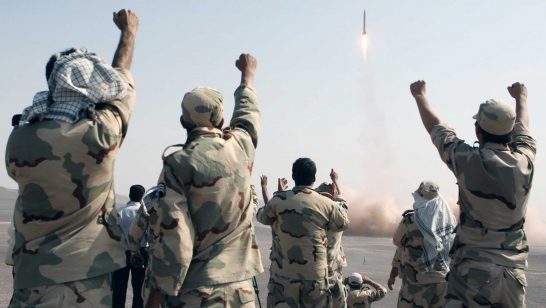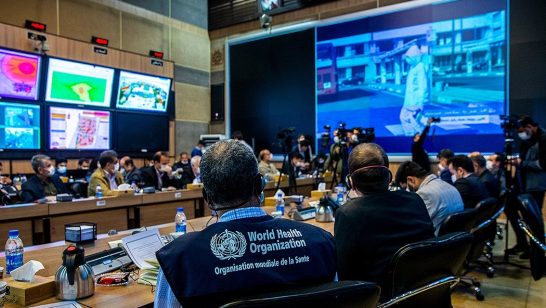
On 22 April, Iran successfully launched its first military satellite, Noor, using the new Qased Space Launch Vehicle (SLV). With the launch of the Qased, Iran has unveiled its parallel space program run by the Islamic Revolutionary Guard’s Corps (IRGC) for the first time. While fears about Iran’s previous space launches serving as cover for ICBM development have been vastly overblown, there are strong indications that Iran’s emerging IRGC track does indeed represent a hedging strategy aimed at acquiring long-range ballistic missile technology.
A parallel IRGC space program
The first sign that the launch of the Qased was different from previous Iranian launches lay with the people who pressed the launch button. While Iranian satellite launches are traditionally conducted by the Iranian Space Agency in cooperation with the Ministry of Defense, the Qased was launched by the IRGC. This novel institutional setup was also reflected in the launch location. The Qased was the first SLV to be launched outside the perimeter of Iran’s Imam Khomeini Spaceport, taking off from the IRGC missile development and launch complex in Shahroud instead. However, the IRGC’s role in the Qased was not merely restricted to launch operations. Both the Qased’s second stage motor, as well as the Noor satellite itself, were developed by the IRGC outside of the regular structures of Iran’s missile industry.
The recent launch was not simply a space launch conducted by the IRGC but rather the unveiling of a full-blown IRGC space program. IRGC Aerospace Force commander Amirali Hajizadeh stated that the IRGC’s space program had advanced in quiet for years and, as per the IRGC’s modus operandi, was only unveiled to the public after a successful test. IRGC Space Commander Jafar-Abadi declared that the IRGC’s space effort was a ‘super project’ which includes SLVs, satellites and ground stations. Open-source research indicates that the IRGC has been operating an SLV development effort in parallel to Iran’s official space program since the second half of the 2000s and that the program was focused on more militarily viable solid propellants from its inception. Even though the IRGC’s space program suffered a severe setback when an explosion killed its leader and devastated its main research facility, the recent unveiling of the Salman, the launch of the Qased, and continuous ground testing at Shahroud offer ample proof that the program is back on track.
Technological advances in solid propellant technology
Iran’s Qased SLV is a three-stage rocket, using a Ghadr liquid-fuelled missile as its first stage, a solid propellant Salman motor as its second stage, and an unknown small kick motor as its third stage. There is little novelty in the choice of a Ghadr as the Qased’s first stage: an improved version of the Shahab 3, the liquid-fuel Ghadr is a standard workhorse of the Iranian missile force and has already served as the basis for Iran’s Safir SLV in the past.
The real innovation of the Qased lies in its second stage: the solid-propellant Salman motor. First unveiled in February of this year, the Salman uses a set of sophisticated technologies including solid propellant, a swivelling nozzle for flight control and a light-weight carbon-fibre casing. Small in dimensions and limited in performance, the Salman is merely intended to serve as an upper stage for space launch vehicles. However, in many ways, it serves as a demonstrator for the technologies crucial to the development of modern, long-range missiles including ICBMs.
There are indications that Iran has already managed to scale up its recent advances in solid propellant technology. IRGC-Aerospace Force commander Hajizadeh claimed that the Qased’s use of liquid fuel Ghadr as a first stage was just a cheap interim solution for testing the Salman and that from now on SLVs would use a solid-propellant first stage. Hajizadeh also stressed that the IRGC was aiming for larger satellites in higher orbits, requiring more powerful launchers by definition. Geospatial analysis of the Shahroud site shows Iran might already have been testing larger diameter motors for several years.
The use of solid-propellant technology marks a significant deviation from Iran’s regular space program, which relies on relatively old liquid fuel technology. It was this outdated liquid fuel technology that shed doubt on American claims that Iranian space launches were merely a cover for ICBM development. While Iran’s large liquid fuel Simorgh SLV could, in theory, serve as a basis for ICBM development, it would be too large and immobile to serve as a viable weapons system. A large solid fuel-SLV, however, could be converted into a viable ICBM with relative ease.
The Qased itself is too limited in performance to serve as an ICBM with any reasonable payload. However, if converted to a ballistic missile, it would exceed Iran’s self-imposed 2000km range limit and represent the first step on the technological path towards an Iranian ICBM capability. How quickly Iran can proceed from this starting point depends on both the progress it has already made in large-diameter motor development, as well as the political willingness of Iran’s leaders.
A satellite launch out of the blue
Another significant alteration from previous space activities was the launch itself. Prior Iranian satellite launches used fixed infrastructure and were accompanied by days-long preparatory phases that generated geospatial signatures as well as local news reports and occasional Western intelligence leaks. By contrast, the Qased was launched from a mobile transporter-erector launcher, similar to the ones used for Iranian ballistic missiles, and came with no advance warnings either from Iranian or Western officials.
This kind of “guerilla launch”, mimicking a ballistic missile operation, is especially significant considering the fact that mobility and launch time preparation were the main reasons Iran’s Safir and Simorgh SLVs were considered badly suited for military use. Iranian officials boasted about the mobility of the system and its capability to be launched anywhere, indicating that the modus operandi chosen for the launch was very much a deliberate signal. With the Qased’s first stage being identical to operational Iranian ballistic missiles, and its second stage being solid-fueled, a potential missile system based on the Qased would not have substantially different levels of mobility or launch preparation time from existing Iranian ballistic missiles.
Strategic outlook
All of these features, as well as historical data from before the 2011 explosion, indicate that Iran’s IRGC-led space program will follow a vastly different logic from Iran’s civilian space program. Whereas Iran’s civilian program uses launchers badly suited for conversion to ballistic missiles, the IRGC’s seems intent on developing launcher technology applicable to long-range missile development and more or less subtly signalling these capabilities. Considering the IRGC’s domestic political and financial clout it can also be expected that the program will have far less oversight by Iran’s elected officials than its civilian cousin.
Of course, it is impossible to detangle these new developments from their broader political context. The US withdrawal from the JCPOA as well as the current administration’s maximum pressure campaign have greatly reduced incentives for restraint in missile and SLV development and emboldened hardliners arguing in favour of such programs. In short, the Islamic Republic has little to lose on the international stage anymore, while escalating missile and space launch vehicle development through flight testing offers a rare chance to return pressure vis a vis the United States and regain political leverage.
While Iran could, in theory, abandon its self-imposed 2000km range limit and start a run for an ICBM as North Korea did in 2017, this seems unlikely for the time being. It appears far more probable that Iran will keep travelling down the SLV path and in doing so will follow a step-by-step approach that combines the gradual escalation ladders, common to Iranian security policy, with the gradual development path that has characterised Iranian missile development. Indeed it seems feasible that the IRGC’s space program will evolve along a track not unlike Iran’s nuclear program, as a hedging effort in which gradual technical improvements are used for maximizing political leverage.
As long as there is time to act, Western decisionmakers should not squander valuable political capital on Iran’s relatively benign civilian space program and on unrealistic demands, such as a halt to all testing and development of Missile Technology Control Regime (MTCR) Category 1 missiles. Instead, it would be more valuable to aim for a formal or informal understanding that reinforces Iran’s 2000km range cap and limits the use of militarily viable fuel technologies in Tehran’s space programs. However, with the IRGC’s solid-propellant space program out in the open, and US-Iranian relations in continuous free-fall, even such a limited agreement seems like a distant goal these days.
The opinions articulated above represent the views of the author(s) and do not necessarily reflect the position of the European Leadership Network or any of its members. The ELN’s aim is to encourage debates that will help develop Europe’s capacity to address the pressing foreign, defence, and security policy challenges of our time.
Image: Sepah News



